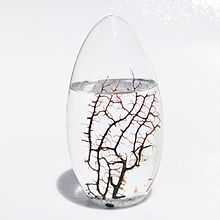Ecosphere (aquarium)

The EcoSphere and "Original Ecosphere" are trademark names for sealed blown-glass miniature aquaria produced by Ecosphere Associates, Inc., of Tucson, Arizona, United States. Spherical or ovoid, the aquaria range from roughly baseball-size to soccer-ball-size. They are sold worldwide as scientific novelties and decorative objects.
The EcoSphere's main visual appeal is provided by tiny red-pink shrimp, Halocaridina rubra, between 1/4 and 3/8 inch (or approximately a centimeter) in length. The shrimp swim energetically around the aquarium, eat the brown bacterial and algal scum on the glass, consume the filamentous green algae which sometimes forms a globular pillow in the water, and perch on a fragment of soft coral.
The main conceptual interest of these objects lies in the fact that they are materially closed ecological systems which are self-sustaining over a period of years. At room temperature, and with only low inputs of light, the algae produce oxygen which supports the shrimp and bacteria. Bacteria break down the shrimps' wastes. The breakdown products provide nutrients to the algae and bacteria upon which the shrimp feed. The manufacturer states that shrimp live in the EcoSphere for an average of 2 to 3 years, and are known to live over 10 years.
A magnetic scrubber is enclosed in each EcoSphere. By passing another magnet over the outside of the glass, the owner can manipulate the scrubber to clean the inside of the EcoSphere.
Biota
The manufacturer does not reveal the species of any of the components of the Ecosphere. However, Hawaiian aquarists readily recognize the shrimp as Halocaridina rubra or a very similar species. H. rubra is native to Hawaii, where it and other tiny shrimp occupy anchialine pools. These are puddles or ponds located near shores and surrounded with lava rock. The pores and chambers of the lava allow seawater to seep into the pools, where it mixes with freshwater from springs or rain. Anchialine shrimp are noted for their great adaptability: they survive in pools of undiluted seawater and in brackish ponds; they tolerate water temperatures over 85 degrees Fahrenheit (near 30 degrees C) when the tropical sun heats up the shallowest anchialine pools, and they also thrive in cool water.
Prior to 1997, the EcoSpheres contained at least one snail at the time of purchase. However, the system is self-sustaining without the snails. (The main function of the snails was aesthetic, as they cleaned scum from the glass.) The Gorgonia coral in EcoSpheres is dead and plays no active biological role in the system, however it does increase the surface area for beneficial bacteria and algae, and the calcium carbonate in the coral acts as a pH buffering agent.
Comparable objects and systems
Commercially packaged aquarium kits, including algae, anchialine shrimp, and a container that can be left open or closed, are available in Hawaii. The customer can combine these to create an aquarium comparable to the EcoSphere.
It is possible to purchase Halocaridina shrimp from Hawaiian aquarium dealers and create home-made sealed aquaria with no other special supplies. Sand, gravel, crushed shell, and very well cycled filtered water from a successful saltwater aquarium, with the lowest attainable ammonia content, should be used. A small inoculation of live Spirulina algae may be introduced. Certain ubiquitous algae and bacteria are likely to be carried by the shrimp themselves and will soon colonize the walls of the container. There is a risk that pathogens also may be introduced.
The Ecosphere inevitably degrades with time. It is actually "self-sustaining" only in comparison to systems which degrade much more quickly.
The advantage of an aquarium closed with a lid (rather than a permanently sealed plug, which is found in the base of an EcoSphere) is that if the system goes out of equilibrium, the owner can remedy conditions and prevent a complete die-off. Intervention to maintain good water quality allows a larger number of shrimp to live in the open system than can survive in the relatively poor quality closed environment.
Freshwater closed systems are often attempted by nature hobbyists and as experimental projects or demonstrations for biology classes. These require nothing more than a large glass jar with an airtight lid, a few cups of lake or river water, and mud or other substrate from the same body of water. Kept indoors at room temperatures, with exposure to sunlight from a window, such systems have been found to contain living organisms even after several decades. The original level of diversity always falls drastically, sometimes exhibiting interesting patterns of population flux and extinction. Multicellular organisms fare poorly. Eventually an equilibrium of micro-organisms is established.
Make Magazine Volume 10 contained instructions for creating a self-contained fresh-water "biosphere", which contained a freshwater amano shrimp, snails, amphipods, ostracods, copepods, rigid hornwort, duckweed, pond scum (for microorganisms), and small rocks or shells (as a pH buffer).
An English pensioner named David Latimer has allegedly managed to keep a sealed plant, Spiderwarts, for 40 years.[1] According to Latimer his Bottle garden begun as an open system, and after a decade Latimer sealed it.
In the media
The ecosphere was reviewed by Carl Sagan in a 1986 Parade magazine article entitled "The World That Came in the Mail."[2] The article is reprinted as a chapter in Sagan's last book, Billions and Billions.
A large version of the ecosphere (about 60 ft. in diameter) is featured as a spacecraft in The Fountain, a 2006 science fiction / fantasy film directed by Darren Aronofsky.
References
- ↑ "MailOnline article".
- ↑ Carl Sagan (1986). "The World that Came in the Mail". Parade Magazine. Retrieved January 18, 2011.
External links
- Make a Tabletop Biosphere from Make Magazine Volume 10